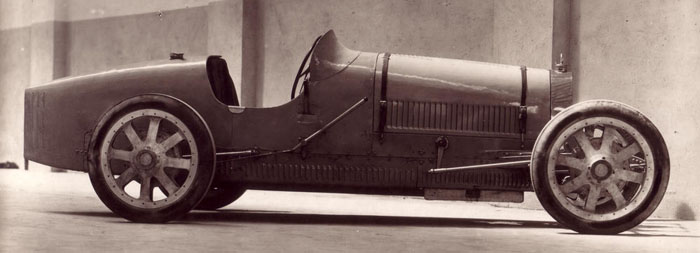
1925 The Thoroughbred Of Racing Cars
Ettore Bugatti registered both the slogan Le Pur Sangre Des Automobiles, and the thoroughbred racing horse profile, as French trademarks. The year before, Bugatti had produced the breakthrough sports car on which his historic reputation is founded. The Bugatti 35, often called the most beautiful car ever designed, was the first sports car capable of hitting 100mph. Equipped with a hollow front axle, cast aluminum wheels, and cable-actuated brakes, the Bugatti 35’s lightweight aluminum body panels tapered gracefully in a continuous line from grill to tail. The Type 35 won 351 races and broke 47 records in 1926, living up to its description as the thoroughbred of automobiles
BUGATTI & THE GRAND PRIX
When people think of Bugatti today, they invariably think of the Type 35. This vehicle was Ettore Bugatti’s masterpiece, and played a huge part in establishing his reputation as one of the world’s finest automotive designers. The Type 35 Grand Prix Bugatti dominated its era, and for almost a decade remained practically unbeatable. It was fast, and featured intelligent design details that were both aerodynamically effective and aesthetically pleasing. Driving the racing car was nothing short of a delight, as the vehicle was unrivalled in its responsiveness, reliability and consistency. The blue racing machine made its debut at the 1924 A.C.F. (Automobile Club de France) grand prix in Lyon. Its slim body was just wide enough in the middle to hold two people – but not if they were at all overweight. The car narrowed at the front into a freestanding radiator, and tapered to a pointed tail.
The front axle was revolutionary for its time, and represented a masterpiece in metalworking – as with everything at Bugatti, it was based around the concept of lightweight construction, and was made out of forged pipe that was hollow in the middle area, and solid at the curved-up ends. The wheels were equally innovative. They were cast entirely in aluminium at the company’s own casting facility, and were extremely light, with built-in rims and brake drums.
After the central wheel nut had been removed, the wheel and brake could be taken off in seconds, allowing for new brake shoes to be fitted quickly and easily – a huge advantage on the racetrack. Just like the famous horseshoe-shaped grille, the aluminium wheel became one of the hallmarks of the brand, and Bugatti was the first ever company to offer aluminium wheels for automobiles. The engine was an in-line eight-cylinder, which initially featured two carburettors, and from 1926, a supercharger. The successes of the Bugatti Type 35 and ist unique place in automotive design history have never been repeated. But what was it that madeEttore Bugatti so different to other manufacturers?
And what enabled Bugatti cars to achieve so many racing victories – almost 2,000 in ten years? Firstly, even in those days, the leading sports car manufacturers aimed to develop their profile through racing success. As a result, races were held almost every weekend throughout Europe, some of them large-scale, others less important. In fact, holding grands prix became quite the fashion – as well as the Monza GP, Italy also hosted an equivalent in Rome. In the same way as today, teams spent the summer criss-crossing Europe to do battle on racetracks such as Targa Florio, and Le Mans, and at the French and Belgian grands prix. Other lesser-known meets included the grands prix of Nice, Antibes and Alsace, as well as much smaller races in local villages.
And secondly, unlike its competitors, Bugatti did not just sell sports and touring cars to ist customers, but also GP models. This meant that owners could race their car at the weekend, and then on Monday, after replacing the wings and lights, could drive it to the office. It may sound unbelievable, but this is how things were done in the 1920s, and a number of races at the time simply would not have taken place were it not for the amount of private racers entering with their Bugattis.
This strategy benefited Bugatti twofold. Firstly, the company was able to sell its vehicles at very high prices to ambitious, wealthy individuals, generating additional capital – something none of its competitors were able to do. In addition, when privately owned Bugattis won races, it helped build the Bugatti profile (and in turn sell more cars), without the company spending a single franc.
In total, over 350 units of the various grand prix models were built. Many of these were destroyed in racing accidents, while others were regularly modified to stay competitive, to the extent that they became unrecognisable from the original designs. In short, they were built to race, and they were not spared the demands, stresses and strains of the track. Following the Second World War, many were simply scrapped as they were too slow and uncompetitive, as well as being too expensive and impractical for everyday use.
Indeed, it would be a number of years before people realised the importance of preserving the model as a piece of European heritage. Unlike other racing cars of the 1920s, which were built purely for competition, the Type 35 featured Bugatti’s proven touring technology and therefore continues to offer an exhilarating ride today. As a result, the vehicle is one of the most widely sought collectors’ cars around the world.


You must be logged in to post a comment.